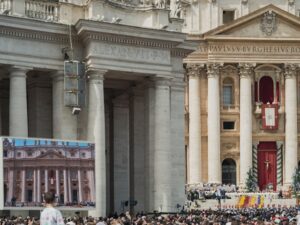The Holy API: Ritual, Protocol and Papal Smoke
The Holy API: Ritual, Protocol and Papal Smoke
Sheng-Hsiang Lance Peng
Every few decades, a curious thing happens in Vatican City: thousands of people turn their eyes to a chimney. This chimney doesn’t stream video or post updates. It doesn’t ring or ping. It smokes. It billows. And when the smoke is white, the world knows: Habemus Papam. We have a pope!
This centuries-old moment (when white smoke curls out of the Sistine Chapel) feels ancient, mystical and perhaps even opaque. But let’s look again. What if, instead of dismissing this as quaint Catholic pageantry, we considered it a form of communication? A system. A protocol. In the language of information science and software engineering: an API.
An API (Application Programming Interface) is a tool that allows two systems to talk to each other. It structures the exchange of data so everyone (or everything) knows what to expect. APIs are everywhere: they let our weather app pull data from a satellite or our online shopping cart talk to our bank. But what if we looked at sacred rituals like APIs too? The papal smoke ritual is a kind of sacred interface, a protocol between the secretive inner workings of the Church and its waiting publics.
—What if we looked at sacred rituals like APIs? The papal smoke ritual is a kind of sacred interface, a protocol between the secretive inner workings of the Church and its waiting publics—
Let’s call it the Holy API.
In the programming world, a protocol is a set of formal rules that ensure information is transmitted in an orderly intelligible way. Likewise, religious rituals often function as highly coded systems: symbolic, repeatable and interpretable only if we know the language.
In the case of the papal election, the rules are strict. The ballots are counted. If no candidate secures the necessary two-thirds majority, the ballots are burned with a chemical that produces black smoke (fumata nera) a message of inconclusion. If the decision is made, the ballots are burned with a different substance to produce white smoke (fumata bianca) signalling a successful election. Only then is a formal announcement made.
 It’s analog. It’s theatrical. It’s slow. But it’s also unmistakable: this smoke is data. The people don’t need access to the ballots or names. They receive a single essential bit of information: yes or no. Pope or not pope. It’s binary in the most literal sense.
It’s analog. It’s theatrical. It’s slow. But it’s also unmistakable: this smoke is data. The people don’t need access to the ballots or names. They receive a single essential bit of information: yes or no. Pope or not pope. It’s binary in the most literal sense.
Marshall McLuhan, the Canadian media theorist, famously argued that “the medium is the message”. In other words, how something is communicated shapes our perception of what is being communicated. That’s especially true of the papal smoke.
In a world driven by instant notifications, push alerts and livestreams, the Vatican still chooses smoke. Fragile, floating, slow to rise and liable to confuse the casual observer. It’s not always easy to tell black from white. For decades, this ambiguity wasn’t even accidental. The smoke’s colour was left deliberately hard to decipher, producing collective murmurs and debate among the crowd. In recent years, chemical additives have been introduced to make the white smoke whiter, the black blacker, but the mystery remains part of the ritual.
This is communication, yes, but it’s also drama. There is no press release, no leak. The smoke appears and the world watches. It is information transmission as performance, designed to inform and also to move, to awe.
In information theory, clarity is often prized. But in sacred systems, opacity can be a form of power. The Vatican doesn’t announce the votes or candidates. The conclave is sealed. The process is confidential. All the world gets is the signal: delayed, theatrical and purified of detail.
This isn’t inefficiency. It’s by design.
The Catholic Church doesn’t just transmit information, it mediates it. By burning ballots, obscuring visibility and wrapping the whole procedure in ritual, the Church reinforces the sanctity of the outcome. The white smoke doesn’t just say, “A decision has been made”, it says, “This decision came through divine guidance, through sacred channels in sacred space”.
It’s not unlike encrypted communication. Cryptography hides the message from the world, revealing only what is meant to be shared. The papal smoke does the same: it reveals only what the public needs to know. Nothing more, nothing less.
Let’s get playful: what if we called the papal smoke the original push notification?
When we receive a message on our phone, we don’t see all the back-end processes that delivered it. We just get the alert. A little icon. A sound. A visual cue that something has happened. The papal smoke works similarly: it’s an event trigger. Something has happened behind closed doors and here’s the public-facing signal.
And unlike most digital push notifications, this one is unmissable. The whole world watches. It gathers people in physical space. It produces collective emotional response. In tech terms, we might say it has high engagement.
There’s a strange comfort in the slowness of it all. The act of watching smoke rise, squinting into the Roman sky, is a kind of ritual in itself. In that moment, millions of people, whether Catholic or curious, experience the same thing: anticipation, observation, revelation. The Holy API has done its work.
In computing, legacy systems refer to outdated software or hardware that’s still in use because replacing it would be costly, complicated or undesirable. They’re often viewed as clunky or inefficient, but sometimes they do things no modern system can. They carry history, context and trust.
Rituals are a kind of legacy system too. They may appear inefficient by modern standards, but they serve a different function: they encode cultural memory and emotional meaning. They don’t just tell us what has happened, they tell us how to feel about it.
The smoke rising from the Sistine Chapel is not just a symbol, it’s a signal. It operates according to rules, protocols and semiotic codes. But more than that, it delivers meaning not through raw data but through sensation.
It is a legacy API. Still running. Still beautiful.
There’s an irony here: while tech companies store our data in “the cloud”, the Catholic Church quite literally sends its message into the cloud: the cloud of incense and smoke that has hung over cathedrals for centuries.
This cloud doesn’t just carry information. It carries atmosphere, history and authority. It communicates through feeling as much as form.
In an age obsessed with immediacy, metrics and transparency, the white smoke from the Vatican reminds us that information doesn’t have to be fast or granular to be powerful. Sometimes, the most potent messages are the simplest: a puff of smoke, a silent announcement, a collective gaze toward the sky.
Cite this article in APA as: Peng, S-H. L. (2025, May 29). The holy API: Ritual, protocol and papal smoke. Information Matters. https://informationmatters.org/2025/05/the-holy-api-ritual-protocol-and-papal-smoke/
Author
-
Dr Peng is a Cornwall-based researcher (Falmouth/Exeter). His research explores a phantasmagoria of marginalised experiences through eerie and unsettling lenses including hauntology (Derrida), monster culture (Cohen) and mnemohistory (Assmann) to reflect on the cultural and social conditions shaping them.
View all posts





